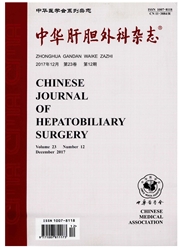

 中文摘要:
中文摘要:
目的 鉴定肝癌肝移植术后肿瘤复发相关蛋白并进行相关生物信息学分析.方法 取肝癌肝移植术后3年患者原发瘤标本,根据肿瘤复发情况,分为复发组(10例)和未复发组(10例).用双向电泳对两组总蛋白进行分离,质谱鉴定差异蛋白;用Gene Ontology和MetaCore软件进行生物信息学分析;用蛋白印迹法测定核纤层蛋白A/C(lamin A/C)的表达.结果 共鉴定出37个差异蛋白,相对于未复发组,复发组中表达上调2倍以上的蛋白16个,表达下调2倍以上的蛋白21个.按Gene Ontology进行分类发现它们主要分布于细胞浆(27%)和细胞器(24%);主要参与体内催化反应(38%)和结合反应(24%)等生物学功能.MetaCore数据库分析,发现多种蛋白参与细胞凋亡、细胞死亡、细胞发育过程的信号调控网络.我们应用蛋白免疫印迹对lamin A/C在两组间的差异表达情况进行了再验证,验证结果与质谱结果吻合.结论 肝癌肝移植术后转移复发与多种蛋白表达改变相关,lamin A/C可能为移植后肿瘤转移复发的潜在分子靶点.
 英文摘要:
英文摘要:
Objective To identify and analyze the key molecules associated with tumor metastasis and recurrence after liver transplantation (LT) for hepatocellular carcinoma (HCC).Methods HCC patients undergoing LT with complete follow-up data were included in this study and were categorized into the recurrence (n=10) and non-recurrence (n=10) groups.The total protein extracted from liver tumor tissues was separated by two-dimensional gel electrophoresis (2-DE).Comparative analyses of 2-DE protein patterns between the two groups were done using computerized image analysis.Differentially expressed proteins (at least two-fold) were identified by MALDI-TOF MS/MS,and were then analyzed by Gene Ontology (GO) and Metacore software.The expression level of lamin A/C was determined by Western blot analysis.Results A total of 37 differentially expressed proteins were identified by MALDI-TOF MS/MS,including 16 up-regulated proteins and 21 down-regulated proteins in the recurrence groiup.GO annotation showed that these proteins distributed predominately in cytoplasm (about 27 %) and organelle (about 24%),and played crucial roles in binding and catalytic reactions.Protein interaction network analysis of all the identified proteins was performed with Metacore software and these proteins might participate in regulation of apoptosis and cell death.We utilized Western blot analysis to validate the down-regulation of lamin A/C in the recurrence group.Conclusion Our study revealed that some proteins might be related to HCC recurrence and metastasis after LT for HCC.Lamin A/C might be used as a candidate biomarker for future diagnosis and a target for therapy.
 同期刊论文项目
同期刊论文项目
 同项目期刊论文
同项目期刊论文
 An immune function assay predicts post-transplant recurrence in patients with hepatocellular carcino
An immune function assay predicts post-transplant recurrence in patients with hepatocellular carcino Genetic Variations in Plasma Circulating DNA of HBV-Related Hepatocellular Carcinoma Patients Predic
Genetic Variations in Plasma Circulating DNA of HBV-Related Hepatocellular Carcinoma Patients Predic IL-17 induces AKT-dependent IL-6/JAK2/STAT3 activation and tumor progression in hepatocellular carci
IL-17 induces AKT-dependent IL-6/JAK2/STAT3 activation and tumor progression in hepatocellular carci Prognostic Indicators for Tumor Recurrence after Liver Transplantation in Hepatocellular Carcinoma a
Prognostic Indicators for Tumor Recurrence after Liver Transplantation in Hepatocellular Carcinoma a Overexpression of CXCL5 mediates neutrophil infiltration and indicates poor prognosis for hepatocell
Overexpression of CXCL5 mediates neutrophil infiltration and indicates poor prognosis for hepatocell Low level of low-density lipoprotein receptor-related protein 1 predicts an unfavorable prognosis of
Low level of low-density lipoprotein receptor-related protein 1 predicts an unfavorable prognosis of Intratumoral IL-17+ cells and neutrophils show strong prognostic significance in intrahepatic cholan
Intratumoral IL-17+ cells and neutrophils show strong prognostic significance in intrahepatic cholan 期刊信息
期刊信息
